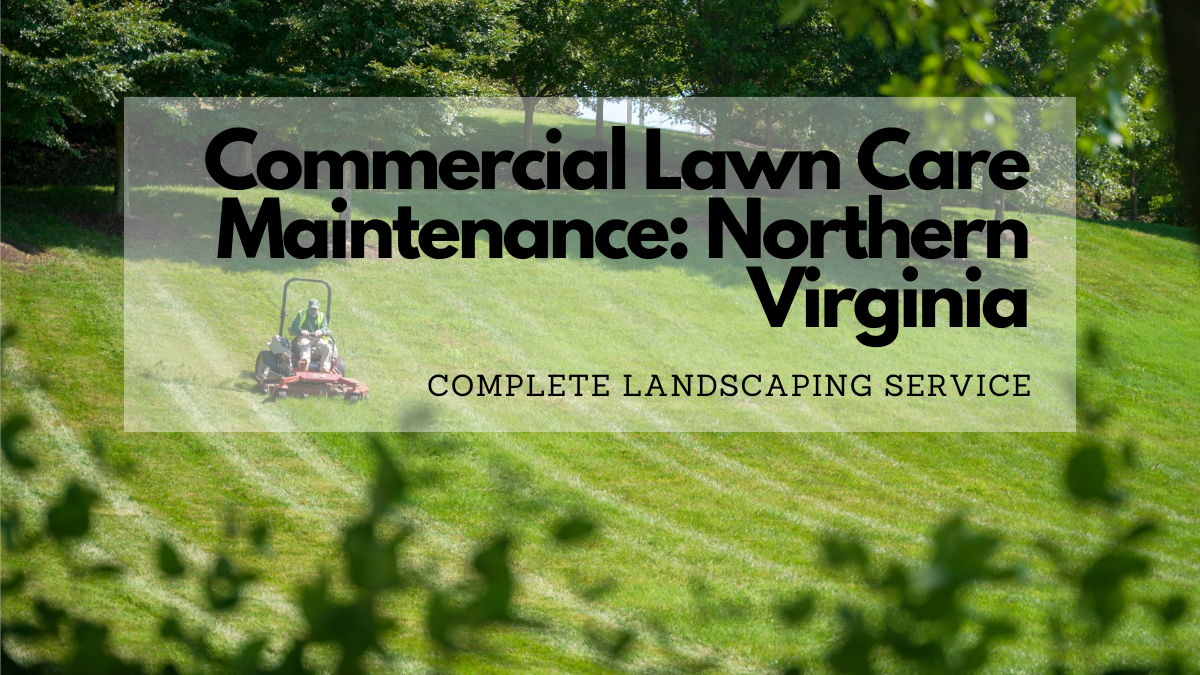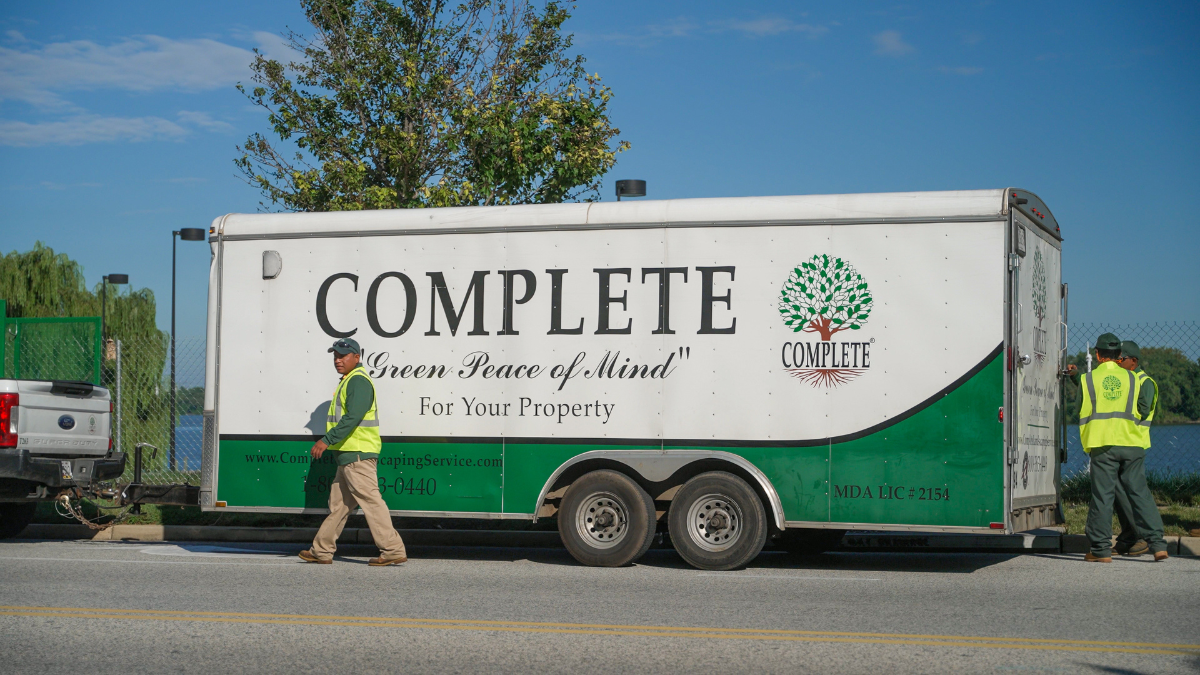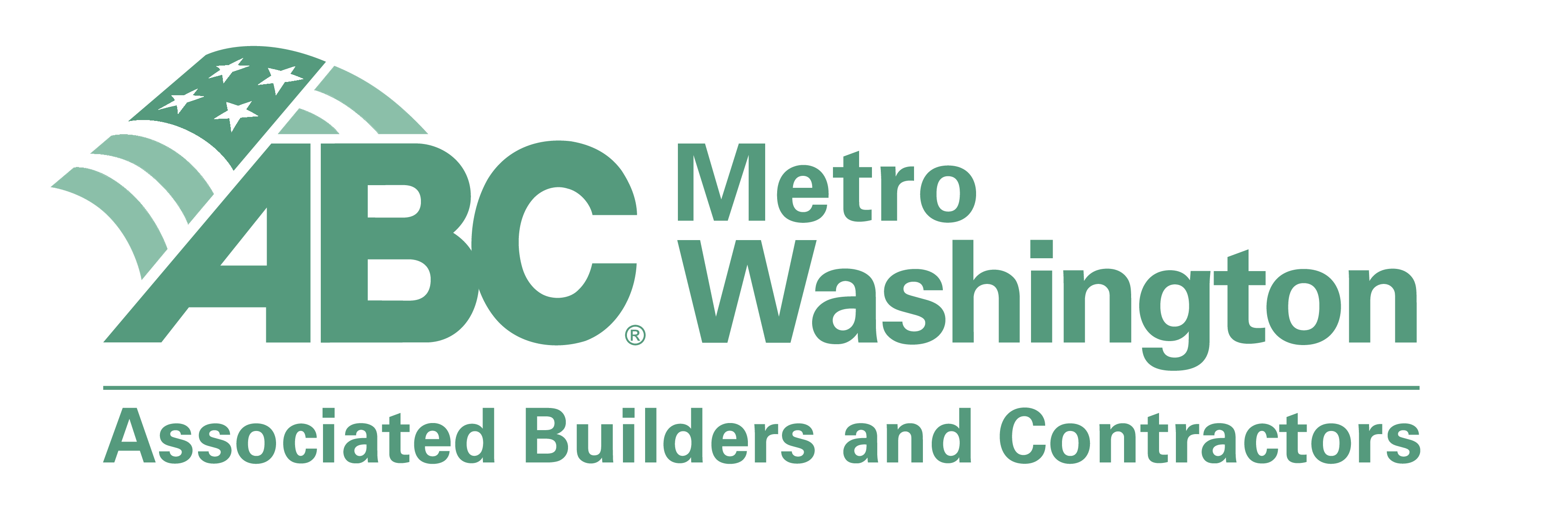Commercial Lawn Care Maintenance in Northern Virginia

Nothing makes a first impression like a beautifully landscaped lawn, whether it’s for your home or your commercial property. Curb appeal is imperative and a well-kept commercial lawn is the foundation of it. A lush lawn is more likely to attract customers to your business and keep them coming back. Is your property in need of a lawn restoration plan? Here are our tried and true commercial lawn care maintenance steps to achieving the lawn you desire.

The Difference Between Commercial Lawn Care and Residential Lawn Maintenance
Commercial lawn care and residential services are very different even though they may have a similar goal in mind. Because of this, there can be a lot of confusion. Even though the services are similar the scheduling is one of the largest differences.
For example, with a commercial lawn care maintenance program, you can expect around 24 mowing cuts, and crews being onsite every 7-10 days. It doesn’t always fall on the same day like residential landscaping does.
Tall fescue, which is the common turf type in Northern Virginia, goes dormant in the summer months. Thus, it grows the most at the beginning of spring and in the fall.
As professional commercial landscape contractors we know that each property has different needs and goals. So, we create unique commercial lawn care maintenance plans for each of our clients to ensure that they have Green Peace of Mind!
Commercial Lawn Services: 5 Steps for Commercial Lawn Care
1. Sweet Talk the Lawn Back into Good Health
The short story is turf grasses do not like acidic or “hot” soils. High Acid soils work well with tomatoes, corn, azaleas, and camellias, but not so much turf grasses. The ideal soil pH for lawn areas should be between 6.5 and 7.0. Soils in this pH range are considered somewhat alkaline or “sweet”, and turf grasses just love it.
How do you achieve sweet soil – apply lime. It’s not an instant fix, it takes time, but as the soil pH goes up, the turfgrass root system can draw up more nutrients, and the nutrients absorbed the healthier lawn, greener color, and stronger root mass.
Soil tests will pinpoint deficiencies both from a nutrient and pH standpoint and will provide essential information which will help us improve the soils over the course of the first year.
2. Keep Crabs in the Bay and Out of the Lawn
Did you know crabgrass can have two generations a year? That’s two chances to wreak havoc on the lawn if left untreated. The solution to turning the tide on the crabgrass is by applying two applications of pre-emergent at key times each year. The first application should be in late Feb or March, and a follow-up application in late April.
These maintenance service treatments will keep the crabgrass seeds that have overwintered in the soil from germinating and taking over the lawn.
3. Not All Grass Seeds are Created Equal
There are cool season grasses and warm season grasses, shade grasses and varieties that prefer the sun; grasses that require a great deal of moisture and those that are extremely drought tolerant. Some of the primary groups of turfgrass include Fescues, Ryegrass, Bluegrass and Bermuda just to name a few.
There are so many to choose from it could be difficult to pinpoint any one specific grass that on its own would provide for the perfect lawn. Sometimes it’s best to blend seeds together to accommodate all areas of a lawn, be they shade or sunny.
4. Loosen Up!
No matter how nutritionally balanced the soil is, or how thorough the fertilization program, if the soil itself is rock hard and compacted, you cannot have a healthy lawn. There is only so much room in the soil for roots, water, air, and organic matter to co-exist. Core Aeration loosens existing soils and gives all of nature’s goodness a place to go.
Water, air, and organic matter need to be able to more easily reach the root zone as they would after a proper aeration. The lawns roots systems will thrive and grow more fibrous in looser soils, making the turf hardy even in drought conditions. When it comes to the soils, we need to loosen up!
5. Keepin’ It Green is Elemental
So here we are:
- pH corrected
- Soil loose and airy
- Right seed for the area
- Well-timed weed program
Is there anything else? Yes, there is one final thing! Just like we need a well-balanced diet of fruits, nuts, veggies, and protein to stay healthy, lawns need a properly balanced diet of Nitrogen, Phosphorus, and Potassium. Nitrogen keeps turf green, while phosphorus builds strong roots and potassium helps to keep the cellular system of the turf healthy and strong.
All three elements are vital but must be applied in the correct balance. This balance is also determined by conducting a soil test which may need to be adjusted from area to area, and season to season.

Commercial Landscape Contractors Near Me: Northern Virginia
If you implement the five steps to restore your commercial property’s lawn outlined here, you can restore the once thick, lush weed-free healthy lawns to their original splendor. Commercial Landscape Maintenance is one of the foundational tools to a successful property. We want to help you be as successful as possible. Let us provide you with Green Peace of Mind and see how your property value grows with each season!
Do you need a Lawn Restoration Program for your commercial property in Maryland, Washington DC, or Northern Virginia? We’re happy to give you a proposal!






